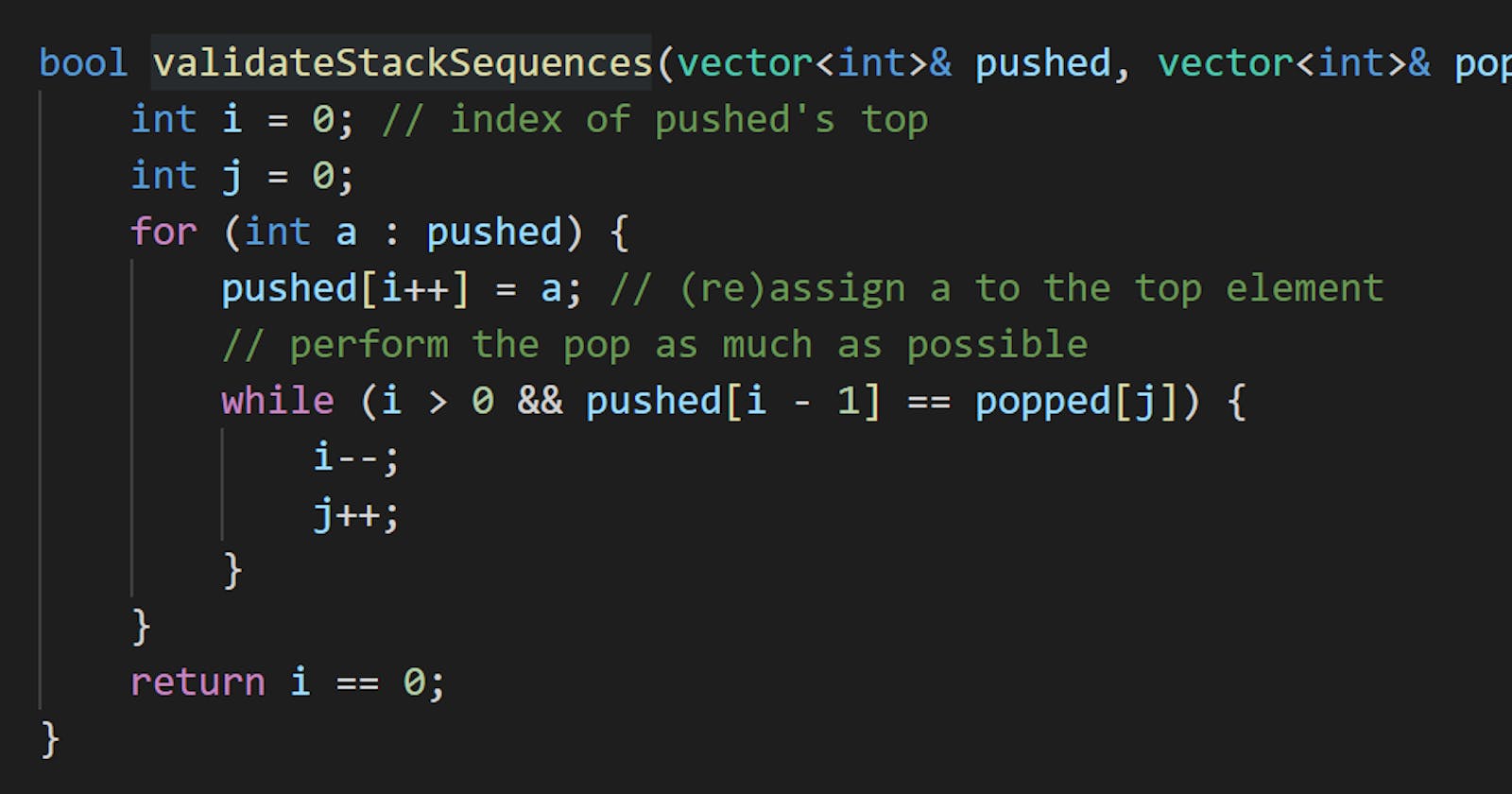Problem statement
Given two integer arrays pushed and popped each with distinct values, return true if this could have been the result of a sequence of push and pop operations on an initially empty stack, or false otherwise.
Example 1
Input: pushed = [1,2,3,4,5], popped = [4,5,3,2,1]
Output: true
Explanation: We might do the following sequence:
push(1), push(2), push(3), push(4),
pop() -> 4,
push(5),
pop() -> 5, pop() -> 3, pop() -> 2, pop() -> 1
Example 2
Input: pushed = [1,2,3,4,5], popped = [4,3,5,1,2]
Output: false
Explanation: 1 cannot be popped before 2.
Constraints
1 <= pushed.length <= 1000.0 <= pushed[i] <= 1000.- All the elements of
pushedare unique. popped.length == pushed.length.poppedis a permutation ofpushed.
Solution 1: Popping by erasure
Step 1. Go through pushed until the popping can be performed.
Step 2. Perform the popping by erasure as much as possible.
Step 3. Continue Step 1 and Step 2 until they cannot be performed anymore.
Example 1
With pushed = [1,2,3,4,5] and popped = [4,5,3,2,1]:
- Go through
pushedstarting frompushed.top = 1untilpushed.top = 4, when the popping can be performed because4 == popped[0]. Only one popping can be performed. Erase (pop) that value,pushedbecomes[1,2,3]. - Continue going through
pushed,pushed.top = 5, and the popping can be performed since5 == popped[1]. Now the popping can be performed fully all values ofpushedandpopped. - End.
Code
#include <vector>
#include <iostream>
using namespace std;
bool validateStackSequences(vector<int>& pushed, vector<int>& popped) {
int i = 0;
int j = 0;
while (i < pushed.size()) {
// perform the popping by erasure as much as possible
while (i >= 0 && pushed[i] == popped[j]) {
pushed.erase(pushed.begin() + i);
i--;
j++;
}
i++;
}
return pushed.empty();
}
int main() {
vector<int> pushed{1,2,3,4,5};
vector<int> popped{4,5,3,2,1};
cout << validateStackSequences(pushed, popped) << endl;
pushed = {1,2,3,4,5};
popped = {4,3,5,1,2};
cout << validateStackSequences(pushed, popped) << endl;
pushed = {2,0,3,1};
popped = {3,1,0,2};
cout << validateStackSequences(pushed, popped) << endl;
}
Output:
1
0
1
Complexity
- Runtime:
O(NlogN), whereN = pushed.length. Though the complexity ofvector::erase()is linear, thepushed.size()is reduced whenever the popping happened. - Extra space:
O(1).
Solution 2: Moving the top
Popping by erasure reduced the length of pushed. But using vector::erase() like that might cost some runtime.
Remember that popping and pushing are performed on the top of pushed. If a popping happened, a pushing right after that is simply a value reassignment on the top element.
Code
#include <vector>
#include <iostream>
using namespace std;
bool validateStackSequences(vector<int>& pushed, vector<int>& popped) {
int i = 0; // index of pushed's top
int j = 0;
for (int a : pushed) {
pushed[i++] = a; // (re)assign a to the top element
// perform the pop as much as possible
while (i > 0 && pushed[i - 1] == popped[j]) {
i--;
j++;
}
}
return i == 0;
}
int main() {
vector<int> pushed{1,2,3,4,5};
vector<int> popped{4,5,3,2,1};
cout << validateStackSequences(pushed, popped) << endl;
pushed = {1,2,3,4,5};
popped = {4,3,5,1,2};
cout << validateStackSequences(pushed, popped) << endl;
pushed = {2,0,3,1};
popped = {3,1,0,2};
cout << validateStackSequences(pushed, popped) << endl;
}
Output:
1
0
1
Complexity
- Runtime:
O(N), whereN = pushed.length. - Extra space:
O(1).
Implementation note
- In the statement
for (int a : pushed), all valuesaof the originalpushedwere stored in a copy ofpushed. So you did not lose any of them.
